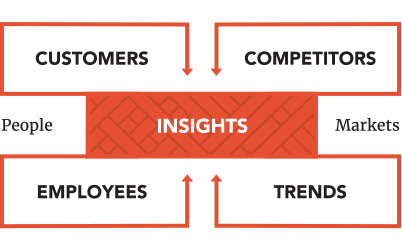POSTED : May 5, 2017
BY : Andrew McLaughlin
Categories: Customer Engagement

Although many firms say customer-centricity is a top priority, far fewer actually gather the data needed to truly understand their customers. Yet, this insight is critical to building a solid foundation for your digital strategy. Transforming your digital customer experience (CX) also requires insight into the broader context of your business, including the people and market forces that influence your long-term success.
The four facets of digital insight fall into two main categories: people and the marketplace. By answering key questions about each of these facets, you can create a continuous flow of valuable intelligence that enables you to establish the vision, culture, content and other essential competencies for digital transformation.

Most organizations have a good idea who they want to sell to and what problem their products and services solve for their current and future customers—or at least they should. But their understanding of their ideal customer often doesn’t go much deeper than job title and size of company. To reach customers with a solution to their problems and a message that resonates, you need to go deeper than the demographics and firmographics and get inside people’s hearts and minds.
There are many ways to understand customers better, and much of the data you need to get started is probably available to you right now in the form of quantitative data, including survey data, web analytics and customer service call logs. Most of us are pretty good at looking at this quantitative data, but too often that’s where we stop, instead of going deeper into qualitative research, which allows us to understand the why.
Quantitative data can tell us how big a problem is; qualitative research can tell us why we have the problem in the first place and point to suggestions for what we should do about it. This type of outside-in customer insight can be found in a number of ways, including voice of the customer programs, social channels, customer reviews, personalization data and user testing.
Successful companies find that combining quantitative and qualitative research results offers deeper insights into customers’ current and desired experience. Synthesizing these to understand the points of friction and opportunity of key personas throughout the customer journey helps digital teams begin to form consensus and make decisions to affect positive change. And creating a formal voice of the customer (VOC) program is an essential ingredient in digital transformation.
Pulling these four facets of digital insight together on a continuous basis helps align digital teams and senior leaders around a mission and vision with the customer at the center. They can also help define the drivers for success and identify the winning moves a company should make to differentiate themselves as market leaders focused on creating great digital experiences.
The other people who should contribute valuable insight are your employees. A successful digital strategy incorporates perspective from the bottom up as well as the top-down—as both exert powerful forces on your organization’s digital future.
Leadership. Executives shape where your organization is going, including what explicit business outcomes will define success, both today and in the future. These are the big-picture results that drive long-term growth, relevance and impact. When shared with others across the company, this type of insight enables the entire organization to navigate toward the north star guiding the digital vision.
For example, your CEO might write a “letter from the future,” which paints a picture of your future success and what you have done to get there. Digital leaders within the company can do the same thing using McKinsey’s Three Horizons of Growth and Innovation, which is an ideal way to tell teams which new customer experiences will make a difference over time.
Front-line employees. No matter how clear the vision, it takes customer-oriented people on the ground to execute the digital strategy. This is where momentum lives. It’s where the competencies needed for digital success are developed and nurtured. It’s not only where today’s core business succeeds or fails, but also where the opportunities of tomorrow emerge and take shape.
Employees who engage directly with customers every day can also generate an ongoing flow of data and insight to feed future innovation. They see first-hand what executive leaders often don’t and what truly makes a difference with customers. At Everence, a faith-based financial services organization with a strong culture of shared values, employees use our “Living the Values” app to provide real-time input about what’s working and what’s not. It also provides a way to recognize team members who are providing an exceptional customer experience. These “A-Player” people often represent the most engaged employees in a company, and they can provide better insights and ideas as to why changes may be needed.
People may be the primary sources of insight, but the market forces that influence your business are also critical. The competition and trends in and out of the digital world can provide insights on the direction of any given market, how quickly innovative solutions are adopted, and where fluctuating market dynamics invite risk.
The most influential players in your organization’s competitive landscape are the leaders who not only own market share, but also mindshare. Looking at the behaviors of these often larger companies helps digital teams look ahead to see what new technologies could be adopted and processes that should be operationalized. Are they buying, building or borrowing their next set of platforms, products, services and solutions? Are they providing a digital customer experience that sets the bar for the industry to reach or represents a minimum viable product in their customers’ minds?
The impact of large disruptors like Amazon and Google are obvious, even if they may not be directly relevant to your industry. But don’t stop there. Look at organizations that are creating the kind of digital customer experience that you aspire to deliver. Even smaller companies, if successful, could impact your business in a big way. What are they doing differently that you can learn from? What new expectations are they creating with customers? How are they raising the bar for operational agility and delivery? And although there may be influential disruptors within your own industry, you may also be able to steal valuable insights from other verticals. For example, what can a healthcare organization learn from a financial service company.
Finally, your research should include marketplace digital trends. You may not have any control over them, but these shifts will most certainly affect your ability to succeed. So find the center of gravity in your business universe. Where is the momentum? Where is the dark matter, those trends such as personalization, which are accelerating but difficult to see?
From artificial intelligence to virtual reality to the internet of things, technology innovation continually pushes the boundaries of what’s possible. Today’s prototypes quickly become tomorrow’s platforms, and the new experiences you create today will be table-stakes in the future. Surfacing the insight on these trends will help you understand where to focus and prioritize digital investments. What’s more, they can be an exciting way for digital teams and executive leaders to vest themselves in innovative customer experiences.
Customer insight provides a solid foundation for a successful digital strategy, but only if your entire organization—from the C-suite on down—understands these insights and uses them to align around customer experience. So ask yourself: “Do we have an ongoing process to collect and analyze customer insights at a cadence that ensures all teams are well-informed and up to date on their current mindsets, experiences and preferences? And do we know enough about our marketplace to predict what our customer might expect from us in the future?”
To further understand the commercial customer’s experience, download our guide.
Tags: Digital Experience, Digital Transformation, Strategy